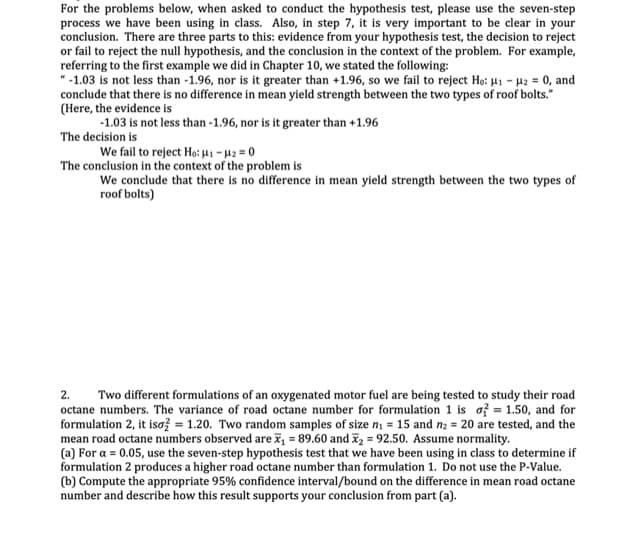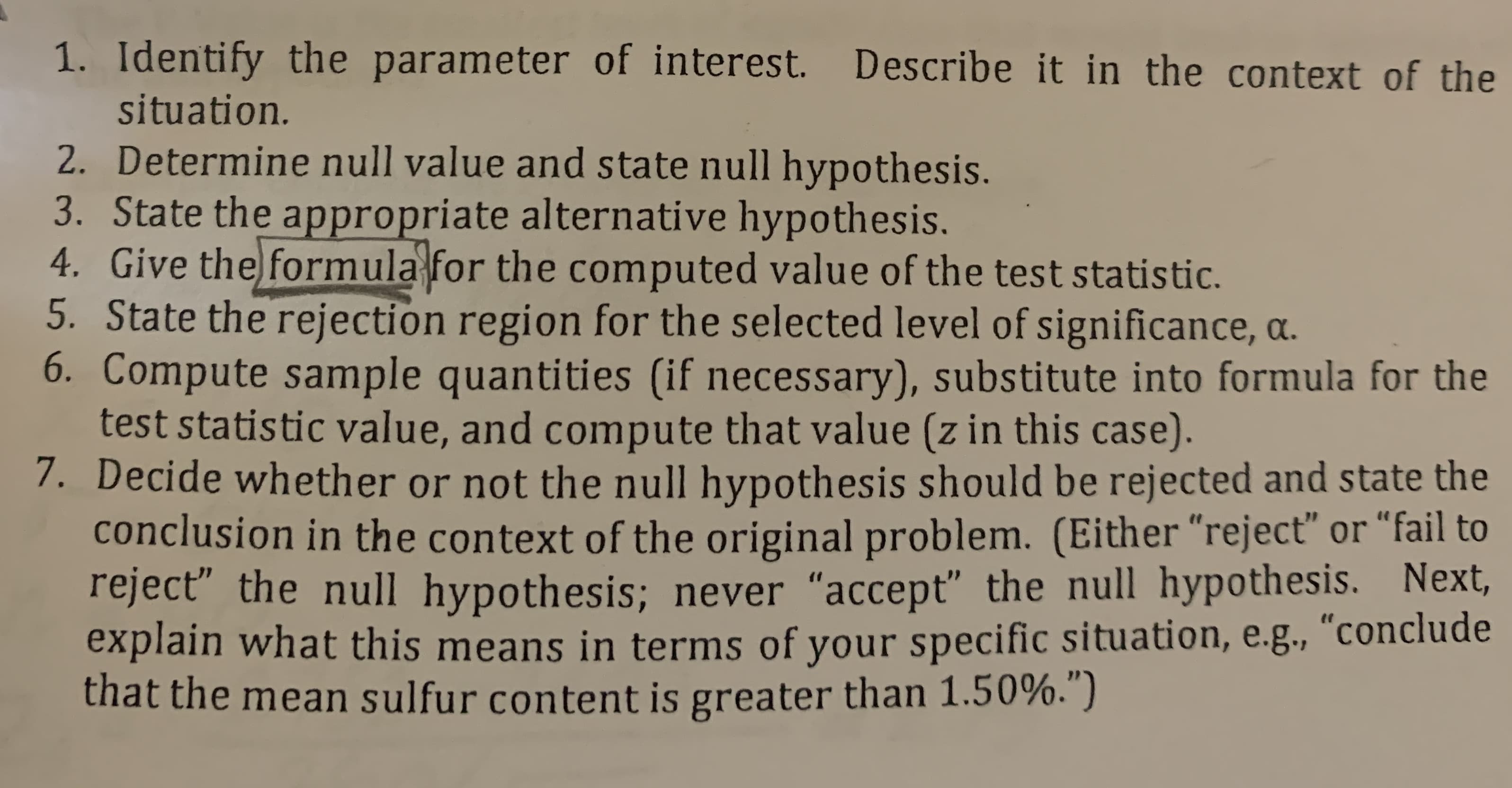For the problems below, when asked to conduct the hypothesis test, please use the seven-step process we have been using in class. Also, in step 7, it is very important to be clear in your conclusion. There are three parts to this: evidence from your hypothesis test, the decision to reject or fail to reject the null hypothesis, and the conclusion in the context of the problem. For example, referring to the first example we did in Chapter 10, we stated the following: -1.03 is not less than -1.96, nor is it greater than +1.96, so we fail to reject Ho: H -H2 0, and conclude that there is no difference in mean yield strength between the two types of roof bolts. (Here, the evidence is 1.03 is not less than -1.96, nor is it greater than +1.96 The decision is We fail to reject Ho: - pg = 0 The conclusion in the context of the problem is We conclude that there is no difference in mean yield strength between the two types of roof bolts) 2. Two different formulations of an oxygenated motor fuel are being tested to study their road octane numbers. The variance of road octane number for formulation 1 is af1.50, and for formulation 2, it isaž = 1.20. Two random samples of size n = 15 and n2 20 are tested, and the mean road octane numbers observed are i = 89.60 and 2 92.50. Assume normality. (a) For a 0.05, use the seven-step hypothesis test that we have been using in class to determine if formulation 2 produces a higher road octane number than formulation 1. Do not use the P-Value (b) Compute the appropriate 95% confidence interval/bound on the difference in mean road octane number and describe how this result supports your conclusion from part (a) 1. Identify the parameter of interest. Describe it in the context of the situation. 2. Determine null value and state null hypothesis. 3. State the appropriate alternative hypothesis. 4. Give the formula for the computed value of the test statistic. 5. State the rejection region for the selected level of significance, a. 6. Compute sample quantities (if necessary), substitute into formula for the test statistic value, and compute that value (z in this case). 7. Decide whether or not the null hypothesis should be rejected and state the conclusion in the context of the original problem. (Either "reject" or "fail to reject the null hypothesis; never "accept" the null hypothesis. Next, explain what this means in terms of your specific situation, e.g., "conclude that the mean sulfur content is greater than 1.50%.")
For the problems below, when asked to conduct the hypothesis test, please use the seven-step process we have been using in class. Also, in step 7, it is very important to be clear in your conclusion. There are three parts to this: evidence from your hypothesis test, the decision to reject or fail to reject the null hypothesis, and the conclusion in the context of the problem. For example, referring to the first example we did in Chapter 10, we stated the following: -1.03 is not less than -1.96, nor is it greater than +1.96, so we fail to reject Ho: H -H2 0, and conclude that there is no difference in mean yield strength between the two types of roof bolts. (Here, the evidence is 1.03 is not less than -1.96, nor is it greater than +1.96 The decision is We fail to reject Ho: - pg = 0 The conclusion in the context of the problem is We conclude that there is no difference in mean yield strength between the two types of roof bolts) 2. Two different formulations of an oxygenated motor fuel are being tested to study their road octane numbers. The variance of road octane number for formulation 1 is af1.50, and for formulation 2, it isaž = 1.20. Two random samples of size n = 15 and n2 20 are tested, and the mean road octane numbers observed are i = 89.60 and 2 92.50. Assume normality. (a) For a 0.05, use the seven-step hypothesis test that we have been using in class to determine if formulation 2 produces a higher road octane number than formulation 1. Do not use the P-Value (b) Compute the appropriate 95% confidence interval/bound on the difference in mean road octane number and describe how this result supports your conclusion from part (a) 1. Identify the parameter of interest. Describe it in the context of the situation. 2. Determine null value and state null hypothesis. 3. State the appropriate alternative hypothesis. 4. Give the formula for the computed value of the test statistic. 5. State the rejection region for the selected level of significance, a. 6. Compute sample quantities (if necessary), substitute into formula for the test statistic value, and compute that value (z in this case). 7. Decide whether or not the null hypothesis should be rejected and state the conclusion in the context of the original problem. (Either "reject" or "fail to reject the null hypothesis; never "accept" the null hypothesis. Next, explain what this means in terms of your specific situation, e.g., "conclude that the mean sulfur content is greater than 1.50%.")
Trigonometry (MindTap Course List)
8th Edition
ISBN:9781305652224
Author:Charles P. McKeague, Mark D. Turner
Publisher:Charles P. McKeague, Mark D. Turner
Chapter8: Complex Numbers And Polarcoordinates
Section: Chapter Questions
Problem 2RP: A Bitter Dispute With the publication of Ars Magna, a dispute intensified between Jerome Cardan and...
Related questions
Topic Video
Question
THIS NOT GRADED ASSIGIMENT , IT IS AN OLD EXAM QUESTION.

Transcribed Image Text:For the problems below, when asked to conduct the hypothesis test, please use the seven-step
process we have been using in class. Also, in step 7, it is very important to be clear in your
conclusion. There are three parts to this: evidence from your hypothesis test, the decision to reject
or fail to reject the null hypothesis, and the conclusion in the context of the problem. For example,
referring to the first example we did in Chapter 10, we stated the following:
-1.03 is not less than -1.96, nor is it greater than +1.96, so we fail to reject Ho: H -H2 0, and
conclude that there is no difference in mean yield strength between the two types of roof bolts.
(Here, the evidence is
1.03 is not less than -1.96, nor is it greater than +1.96
The decision is
We fail to reject Ho: - pg = 0
The conclusion in the context of the problem is
We conclude that there is no difference in mean yield strength between the two types of
roof bolts)
2.
Two different formulations of an oxygenated motor fuel are being tested to study their road
octane numbers. The variance of road octane number for formulation 1 is af1.50, and for
formulation 2, it isaž = 1.20. Two random samples of size n = 15 and n2 20 are tested, and the
mean road octane numbers observed are i = 89.60 and 2 92.50. Assume normality.
(a) For a 0.05, use the seven-step hypothesis test that we have been using in class to determine if
formulation 2 produces a higher road octane number than formulation 1. Do not use the P-Value
(b) Compute the appropriate 95% confidence interval/bound on the difference in mean road octane
number and describe how this result supports your conclusion from part (a)

Transcribed Image Text:1. Identify the parameter of interest. Describe it in the context of the
situation.
2. Determine null value and state null hypothesis.
3. State the appropriate alternative hypothesis.
4. Give the formula for the computed value of the test statistic.
5. State the rejection region for the selected level of significance, a.
6. Compute sample quantities (if necessary), substitute into formula for the
test statistic value, and compute that value (z in this case).
7. Decide whether or not the null hypothesis should be rejected and state the
conclusion in the context of the original problem. (Either "reject" or "fail to
reject the null hypothesis; never "accept" the null hypothesis. Next,
explain what this means in terms of your specific situation, e.g., "conclude
that the mean sulfur content is greater than 1.50%.")
Expert Solution
This question has been solved!
Explore an expertly crafted, step-by-step solution for a thorough understanding of key concepts.
This is a popular solution!
Trending now
This is a popular solution!
Step by step
Solved in 7 steps with 6 images

Knowledge Booster
Learn more about
Need a deep-dive on the concept behind this application? Look no further. Learn more about this topic, statistics and related others by exploring similar questions and additional content below.Recommended textbooks for you

Trigonometry (MindTap Course List)
Trigonometry
ISBN:
9781305652224
Author:
Charles P. McKeague, Mark D. Turner
Publisher:
Cengage Learning

Big Ideas Math A Bridge To Success Algebra 1: Stu…
Algebra
ISBN:
9781680331141
Author:
HOUGHTON MIFFLIN HARCOURT
Publisher:
Houghton Mifflin Harcourt

Trigonometry (MindTap Course List)
Trigonometry
ISBN:
9781305652224
Author:
Charles P. McKeague, Mark D. Turner
Publisher:
Cengage Learning

Big Ideas Math A Bridge To Success Algebra 1: Stu…
Algebra
ISBN:
9781680331141
Author:
HOUGHTON MIFFLIN HARCOURT
Publisher:
Houghton Mifflin Harcourt